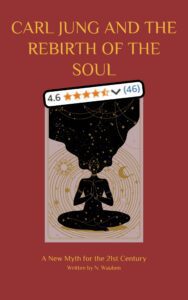Table of Contents
Introduction
In his book The Divided Self, Ronald Laing argued that there is a tension within most individuals between two personas: the one that is our true authentic self and the one that we show to the world. Laing argued that this division, when it reaches a certain degree, might result in mental issues.
Luckily, most people do not have, or at least appear not to have any major mental issues. It might, however, still be important for us to understand what Laing meant with this tension between these two personas. If we become aware of this inner conflict we might not only recognize and prevent mental illness, but we can also get more in touch with our true selves, which, as you may have seen in part 1 and part 2 on Carl Jung’s Red Book, has some important benefits as well.
Mental Illness According to Ronald Laing
Biological Birth and Existential Birth
In The Divided Self Ronald Laing argued that an important cause of mental illness originates from an individual’s sense of being disconnected from his or her body. Laing Indicated that we take it for granted that when an individual is born (biological birth), this new-born baby will soon also feel that he or she is alive as an individual in this world (existential birth).
If everything goes according to plan, then this new-born individual will experience his newfound existence as real and separated from the rest of the world:
“The individual, then, may experience his own being as real, alive, whole; as differentiated from the rest of the world in ordinary circumstances so clearly that his identity and autonomy are never in question; as a continuum in time; as having an inner consistency, sustainability, genuineness, and worth; as spatially coextensive with the body; and, usually, as having begun in or around birth and liable to extinction with death. He thus has a firm core of ontological security.” (p.42)
However, if something in this development goes wrong, a development which we take for granted and should occur automatically, then the individual, according to Laing, might not ‘feel’ his own existence in this world and might not be able to recognize where he or she begins and where the world begins. Biologically the baby has been born, but existentially not yet. When this occurs, some serious complications arise according to Laing:
“The individual in the ordinary circumstances of living may feel more unreal than real; in a literal sense, more dead than alive; precariously differentiated from the rest of the world so that his identity and autonomy are always in question. He may lack the experience of his own temporal continuity. He may not possess an over-riding sense of personal consistency or cohesiveness. He may feel more insubstantial than substantial, and unable to assume that the stuff he is made of is genuine, good, valuable, and he may feel his self as partially divorced from his body.” (Ronald Laing, The Divided Self, p.42)
Fundamentally such an individual will not feel secure of his own existence and his existence in this world mainly because he or she is not really connected to his or her own body.
There are more ways in which this separation can occur. Trauma on the one hand, can be an important seed for such a separation, which has been extensively discussed by Bessel van der Kolk in his interesting book The Body Keeps the Score. Ronald Laing in The Divided Self, on the other hand, focuses mainly on another source for such a separation, mental illness, which, of course, might also be a result of trauma, among other potential causes.
The Self as a Vacuum
Whatever the reason might be for the separation between an individual’s self and his or her body, this separation has major implications according to Ronald Laing.
In essence, the self, by separating itself from the body and the real world, tries to find safety and security (which it might have been lacking since birth or since an event or series of events later in life). Laing argued that a self will then develop which can be seen as a vacuum: “a self is liable to develop which feels it is outside all experience and activity. It becomes a vacuum. Everything is there, outside; nothing is here, inside. Moreover, the constant dread of all that is there, of being overwhelmed, is potentiated rather than mitigated by the need to keep the world at bay.” (p.80)
As a result of this detached and separated self, the self is never present in the world through the actions of the individual. The individual has essentially constructed a persona that is detached from his or her true self and then uses this constructed part (the false self) to communicate with the world. Laing observed that if this happens, then the world will lose its realness, similar to the child that never managed to acquire such a perception of the world in the first place: “If the individual delegates all transactions between himself and the other to a system within his being which is not ‘him’, then the world is experienced as unreal, and all that belongs to this system is felt to be false, futile, and meaningless.” (Ibid)
The self is afraid to reveal itself to the world because it fears it will be overwhelmed by everything that is ‘out there’. Consequently, the self will begin to live more and more in a phantasy world, which, according to Laing, results in a vicious circle: “Phantasy, without being either in some measure embodied in reality, or itself enriched by injections of ‘reality’, becomes more and more empty and volatilized. The ‘self’ whose relatedness to reality is already tenuous becomes less and less a reality-self, and more and more phantasticized as it becomes more and more engaged in phantastic relationships with its own phantoms.” (p.85)

Being Aware of the False Self
Luckily, most people will never develop a false self that has such disastrous consequences as those experienced by the individuals described by Ronald Laing. At the same time, however, it can be argued that every individual has developed a false self to some degree. Although this might not result in a vicious circle of detachment from the real world and a complete sense of meaninglessness, it can still have some negative consequences if left unchecked.
Living in a Phantasy World
According to Laing, if one were to live too much in a world of phantasy, because one wants to remain in control of, and secure of his own existence in the world to an excessive degree, the individual might never fulfil his or her true potential. By developing a false self, one believes one is more secure from the world because no-one can define or grasp him or her and therefore no-one can hurt him or her as well: “But he must at all costs never be what his act is. If he were what his act was, then he would be helpless and at the mercy of any passer-by.” (p.88)
Thereby, as long as the self does not reveal itself everything remains possible: “The self as long as it is ‘uncommitted to the objective element’, is free to dream and imagine anything. Without reference to the objective element it can be all things to itself — it has unconditioned freedom, power, creativity.” (p.89) This freedom, however, does not exist in the real world and all the creative power is focused upon the inner world, a world that will never be revealed.
Being Good
Besides living in a phantasy world, to promote one’s sense of security, individuals, according to Ronald Laing, also tend to try to improve their sense of security by doing whatever is in their power in order to be perceived of as ‘good people’.
According to Laing it is often the case that individuals that are trying to be of no trouble to anyone and always do what they are told are not doing so because they are simply good people, but because they want to hide their true self and are afraid of the consequences if they stop to conform. Ronald Laing indicated that: “Being good is not, however, done out of any positive desire on the individual’s own part to do the things that are said by others to be good, but is a negative conformity to a standard that is the other’s standard and not one’s own, and is prompted by the dread of what might happen if one were to be oneself in actuality.” (p..98)
Similarly to living in a phantasy world, excessively trying to be good hinders one from fulfilling one’s true potential: “This compliance is partly, therefore, a betrayal of one’s own true possibilities, but is also a technique of concealing and preserving one’s own true possibilities, which, however, risk never becoming translated into actualities if they are entirely concentrated in an inner self for whom all things are possible in imagination but nothing is possible in fact.” (p.98)
Conclusions
There are many reasons for an individual to develop a false self. As we have seen throughout this discussion on The Divided Self written by Ronald Laing, these can range from mental illness to solely trying to increase one’s sense of security from an outside world, that can be seen as an overwhelming force that threatens the true self. However, as Ronald Laing indicated, the efforts taken to protect the true self often tend to hurt the true self in the end.
By hiding the true self, one also hides one’s potential and creativity from the world, which can of course be an unfortunate development. I believe that it might be important for everyone to be aware of this inner conflict and to be incredibly careful not to sacrifice one’s true self for the sake of a false self. Sadly, however, as observed by Ronald Laing, this is extremely difficult for those who have experienced trauma or have a mental illness.

